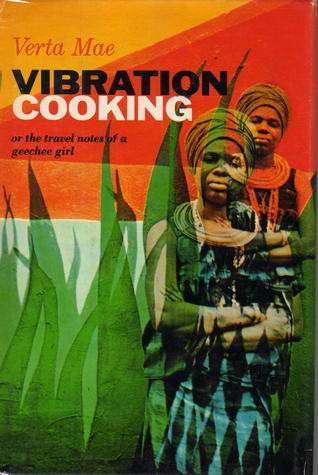What do you think?
Rate this book


First published January 1, 1970
In Paris I used to eat what they called crepes ... delicate to make and you have to have an expensive and fancy pan to make them. I prefer hoe cake like Grandmama Sula used to make ... Hoe cake got its name from the hoe. Slaves would cook batter on the flat edge of the hoe in the fields for the noonday meal. You don't have to cook it on the metal part of the hoe cause we ain't slaves no mo'. [p.16]
For the 'Cookbook by a Woman of Colour' prompt of the I wanted a cookbook that was more than just a collection of recipes, and Vertamae Smart-Grosvenor's 1970 Vibration Cooking was highly recommended. I even bought a paperback, rather than an ebook!
This was a book to dip into at intervals, rather than read straight through. The author had already lived a colourful life in her first three decades: born in South Carolina, her family moved to Philadelphia, then Vertamae went to Paris (via Dover, where she pretended to be an African princess) to study theatre, before moving to New York City and becoming an actress and a member of Sun Ra's Solar-Myth Arkestra. (Later, she would have a small role in the film of Toni Morrison's .) She was friends with Maya Angelou and Nina Simone: the book is peopled with her other friends, passing on recipes, talking about food, eating and drinking. Wherever Vertamae Smart-Grosvenor went, she was fascinated by food and how it reflects culture.
I learnt that 'Geechee' is another name for 'Gullah', the term for African-Americans who live in the south-east US and have a creole language and a distinct ethnic identity. Smart-Grosvenor, born into this culture, defines herself as Black and Afro-American: she embraces her African roots and notes that she was treated with more respect in Europe when wearing African clothes than when wearing 'Western' clothes. She writes of 'soul food' but does not equate it with 'food that has been cooked by black hands': "any Veau √Ý la Flamande or Blinchishe's Tvorogom I prepared was as 'soulful' as a pair of candied yams". And she highlights culinary cultural appropriation, whether it's the gourmet adoption of collard greens or terrapins or pigs' feet, all of which were staples of African-American cuisine for decades if not centuries.
This was an interesting read, though mostly for the stories between the recipes -- and the glimpses of a recent, more prejudiced past -- rather than the recipes themselves. That said, though I'm not an enthusiastic cook, I intend to try her recipe for 'Codfish and Ackee Jamaica Style'.